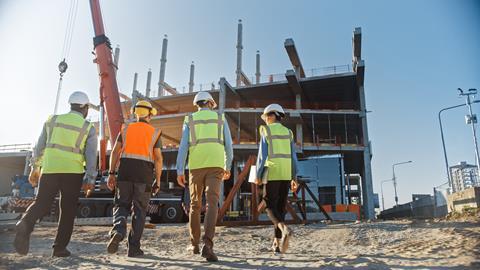We are now, hopefully, two months into the first year since 2019 that will not be defined by Covid. While the pandemic still presents problems, businesses are now able to look to the years ahead with the optimism and ambition that has been lacking for the past two.

For property developers specifically, we foresee a lot of challenges in 2022 and beyond – but also a lot of opportunities.
The first of these challenges comes from the planning system. The government’s desire for planning reform raises a lot of questions over where homes can be built and under what circumstances. Meanwhile, frequent changes in housing ministers and housing secretaries create a lack of consistency when it comes to planning policy.
One area where government policy is consistent – at least for now – is sustainability. Tougher Minimum Energy Efficiency Standards (MEES) regulations are coming for commercial as well as residential buildings. From 1 April 2023, buildings with an EPC rating lower than ‘E’ will not be permitted to be let out. In addition, MEES regulations that are currently working their way through parliament will make it illegal to lease an office with an Energy Performance Certificate (EPC) with a rating lower than ‘B’ by 2030.
Streamlined Energy and Carbon Reporting is also beginning to have an impact on larger businesses. Companies that do this properly are potentially going to get more opportunities and be more successful in tendering for projects.
While a push for greener real estate is undoubtedly a good thing for everyone in the long run, there are many landlords and developers out there who have a long way to go if they have any hope of meeting these new standards. According to data published by Cushman & Wakefield, only 4% of buildings in London have an EPC rating of at least ‘B’. Too many companies do not seem ready to have this conversation yet. For some, it is also a financial challenge as they are still tight on liquidity given the past couple of years’ trading.
Now is the time for longer-term planning, for reassessing market needs and to be proactive rather than reactive. That means active engagement in planning reform, transparent reporting to better access finance for tech investment and dealing with energy requirements
The challenge of making buildings more sustainable is likely to be compounded by the issues currently faced by the construction industry. Both materials and labour are soaring in price thanks to a combination of Covid, inflation and Brexit. All those issues look likely to hang around for a while, which means the cost of labour could remain an issue for years to come.
Businesses operating in the construction sector must continue to evolve and adapt in order to remain profitable and meet the needs of their customers. Building techniques and technologies in the UK have remained largely the same for decades. Adapting, updating and improving this requires investment, which is a big ask right now. However, investment is vital because the alternative is the continued increase in costs and the possibility that both the UK construction industry and the UK as a whole will begin to fall behind.
Lending issue
The wariness of investors at the moment presents a problem for developers as well as construction companies. Developers like to have funding in place before they start on a project, but banks are much less willing to lend against development than they might have been pre-pandemic. Real estate is still an attractive investment for banks, but the cost of bank debt is only going to go up and covenant strength is likely to be increasingly important. So too are transparent and robust financial reporting and strong corporate governance. This, combined with the continued increase in construction costs, means many developers may struggle to make a profit without a strong tenant mix and a solid ESG agenda.
With so many challenges ahead, it is easy to forget the myriad of opportunities available for developers as well. The most obvious one is demand for the industry’s two strongest asset classes: homes and warehouses. Neither housebuilders nor industrial developers can put up buildings quickly enough right now to meet the sky-high levels of demand.
Despite headlines about the government’s supposedly hostile attitude towards housebuilders, housing remains one of the government’s top five priorities. Unless the government changes tack dramatically and starts building homes itself, it will remain dependant on private housebuilders and private residential developers of all kinds to deliver the housing the UK continues to need. That presents a big opportunity for those companies.

Industrial development has also been booming over the past few years. Thanks to demand for online shopping, a variety of occupiers have emerged who need logistics space to do business. In London and the South East, where the population density is high and the amount of free space is low, warehouse rents have soared. This has seen many institutional funds pour money into buying both existing warehouse space and development land on which to build warehouses.
Demand for self-storage space is also booming thanks to a change in the way people live. Many young people have moved to London, acquired a lot of possessions and have since moved away from London. This cycle creates a steady stream of customers who need to store their stuff somewhere temporarily.
As well as developing new real estate, redeveloping existing real estate and changing use classes also present an opportunity for developers. While examples of retail-to-flexible-workspace or office-to-residential used to be few and far between, there are now many successful examples of both.
Of course, redevelopment does not necessarily require a change of use. For many developers, opportunities lie in the flight to quality office space. Grade-B office space reimagined as amenity-rich grade-A office space has the potential to create a lot of value.
Demand for retail
The same is true for retail space. The ‘death of retail’ is a common refrain, but it’s also an oversimplification. One trip to Oxford Street in London or down Fifth Avenue in New York will show you clearly that demand for retail is there.
The key is to create an experience, a place where people want to visit. And this isn’t just a lesson for luxury retailers. Mainstream retailers that are providing ancillary offerings such as virtual assistants, in-store gyms and cafe facilities have shown the experience you can create for shoppers while keeping stock prices reasonable.
Developers might not see this need for retail transformation as their problem, but it is at least in part. The developers with vacant retail units are the ones who have not engaged with this opportunity, but the successful ones are those who are on the phone to retailers. They are going to them with property management and advisory solutions.
The developers who come up with solutions rather than waiting until solutions come along are the ones who will really thrive in 2022 and beyond. The construction industry and property developers have typically operated hand to mouth, but this attitude is dated. Now is the time for longer-term planning, for reassessing market needs and to be proactive rather than reactive. That means active engagement in planning reform, transparent reporting to better access finance for tech investment and dealing with energy requirements. It also means effective tax planning, especially given HMRC’s continued focus on real estate as a source of revenue.
Those who do all of these things will be better placed to address the challenges ahead and will be presented with a great pipeline of opportunities.

About Buzzacott
Buzzacott is a top-25 UK accountancy and business advisory firm with a reputation for supporting clients for more than 100 years.
Our real estate team provides audit, assurance and tax advice to businesses operating across the whole real estate spectrum, including partnerships and property funds as well as corporates who either own or occupy real estate or operate in the sector.
Whether you’re dealing with changes in government regulations and tax law or managing market risks, our sector experts know the issues you face and have the experience to deliver the solutions you need.
With more than 450 staff based in the City of London, we have the expertise expected from a large firm delivered with empathy and in a relationship-focused way that you might expect from a small firm





























No comments yet